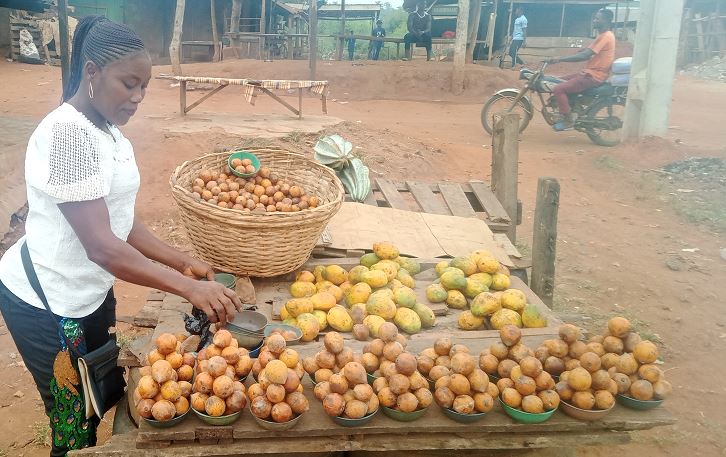Socio-economic contributions of forest products to livelihoods in Yewa north local government ogun State Nigeria
DOI:
https://doi.org/10.20873/jbb.uft.cemaf.v9n1.olawumiPalabras clave:
wild foods, conservation, household sizeResumen
The study assessed contributions of forest products to nutrition and livelihoods in Yewa North Local Government of Ogun State, Nigeria. The main objective of the study found out the socio-economic contributions of the forest foods towards livelihoods in Yewa North Local Government Area of Ogun State, Nigeria. The specific objectives; identified and described the socio-economic characteristics of the respondents, identified the available edible forest/wild plants and animals in the study area, determined the socio-economic factors influencing the use of forest foods in the study area as well as described major problems facing forest food collection, processing, marketing and consumption in the study area. Three hundred and fifty (350) respondents randomly selected from major communities were interviewed with questionnaire. Data generated were analysed using descriptive statistics and logistic regression. Majority (65%) were males (88%) between 21 and 60 years. The principal household size was 6-10 (60%) persons; major occupation is farming (41%). Farm sizes were below a hectare. Majority (75%) lived in concrete houses and mud houses (22%). About half (45%) of the respondents uses water closets, pit latrines (32%) while 20% defecated in nearby bushes. Ninety percent possessed mobile phones for communication and 68% indicated availability of conventional medical facilities. Drinkable water was sourced from private boreholes (31%), public water (46%), streams (27%) and wells (12%). The source of energy is national grid (91%), kerosene stoves (56%) and firewood (28%). The respondents indicated high assets index in terms of household assets (81%) and farm assets (92%). Twenty-two plant species were identified of which 95% were eaten and twenty animal species were identified. Logistic regression model showed that sex and household size tended to increase the odds in favor of consumption of forest foods while age, educational farm size and tools owned tended to decrease consumption of forest foods. The principal problems confronting respondents were lack of storage facilities, poor transportation and shortage of wild foods during off seasons. The study concluded that forest products contribute significantly to livelihoods and recommends domestication and conservation.
Citas
FAO. An analysis of socio-economic issues, 2013. (Available at: http/: www.fao.org/…/t612e02.htm).
FAO. Wildlife utilization and food security Africa. Rome; FAO. pp 1-8,1995.
Hassan SM, Ikuenose CE, Jalloh A, Nelson GC, Thomas TS. 2013. Nigeria; West African agriculture and climate change - a comprehensive analysis, chapter 10: 259-290. International Food Policy Research Institute, USA.
Irz X, Lin L, Thirtle C, Wiggins S. 2002. Agricultural produc-tivity growth and poverty alleviation. Development Policy Review. vol.19 (4): 449-466.
Jibowo AA. 1998. Agricultural transformation; the secrete of national food surplus. An Inaugural Lecture Delivered on July 11th at Tthe Obafemi Awolowo University, Ile Ife, Ni-geria.
Jimoh SO. Sustaining the roles of non-timber forest products in rural poverty reduction and household food security in nigeria. Journal of Fisheries International. v.1, n.2, p.63-69, 2006.
Musukwe NW, Mbalule MI. 2001. Agroforestry, agriculture in Uganda Vol. III (Forestry); National Agricultural Re-search Organization, (Mukiibi, J.K, Eds.), Fountain Pub-lishers, CTA/NARO, Chapter 2: p.34-47.
Shaanker KN, Ganeshaiah S, Krishnan R, Ramya, Meera C. 2004. Livelihood gains and ecological costs of non-timber forest products dependence”. Assessing the roles of de-pendence, ecological knowledge, and marketing structure in three contrasting human and ecological settings in South In-dia, Environmental Conservation. v.31, n.3, p.242-253.
Shackleton CM, Shackleton S. The importance of non-timber forest product in rural livelihood security and as safety net. A review of evidence from South Africa. South Africa jour-nal of Science. pp.100-658, 2006.
Sodiya CI, Aromolaran AK, Alarima CI, Adubi KO, Armed AA, 2017. Involvement of rural youths in the marketing of non-timber forest products in odeda local government area, Ogun State, Nigeria, Annals of Child and Youth Studies, Aa Multidisplinary Academic Journal of the International Research and Development Network of the Children and Youth in Agriculture Programme in Nigeria (CYIAP-Network Publishing), pp.186-203.
Wollenberg E, Septiani NA. Estimating the incomes of people who depend on forest. In E. Wollenberg, A, Ingle (eds): In-comes and the forest products for local communities. Bogor: Centre for International Forestry Research. pp. 157-187, 1998.

Descargas
Publicado
Cómo citar
Número
Sección
Licencia
Copyright (c) 2024 - Journal of Biotechnology and Biodiversity

Esta obra está bajo una Licencia Creative Commons Atribución 4.0 Internacional.
Los autores que publican en esta revista aceptan los siguientes términos:
Los autores mantienen los derechos autorales y conceden a la revista el derecho de primera publicación, con el trabajo simultáneamente licenciado bajo la LicenciaCreative Commons Attribution (CC BY 4.0 en el link http://creativecommons.org/licenses/by/4.0/) que permite compartir el trabajo con reconocimiento de la autoría y publicación inicial en esta revista.
Los autores tienen autorización para asumir contratos adicionales separadamente, para distribución no exclusiva de la versión del trabajo publicado en esta revista (ej.: publicar en repositorio institucional o como capítulo de libro), con reconocimiento de autoría y publicación inicial en esta revista.
A los autores se les permite, y son estimulados, a publicar y distribuir su trabajo online (ej.: en repositorios institucionales o en su página personal) en cualquier punto antes o durante el proceso editorial, ya que esto puede generar alteraciones productivas, bien como aumentar el impacto y la citación del trabajo publicado (disponible en El Efecto del Acceso Libre en el link http://opcit.eprints.org/oacitation-biblio.html).


